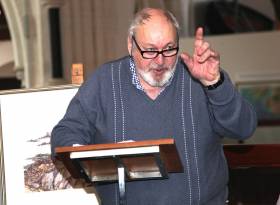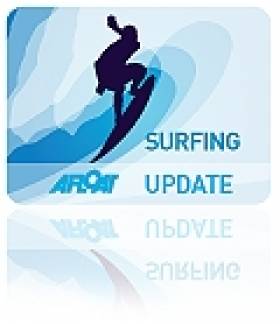Displaying items by tag: Obituary
The heartfelt sympathies of all those with extensive interests in the culture and history of the maritime world are with Cormac Lowth of Dublin and his sons on the sad loss of his wife and their mother Barbara, writes W M Nixon.
Cormac Lowth is a man of the most extraordinary range of interests in all aspects of seafaring history and the art and the life of coastal communities, particularly in the Dublin area, and his lectures on an extensive range of topics draw fascinated audiences to learn more about an enthusiasm he has developed extensively after spending part of his working life at sea as a professional seafarer.
Not only does Cormac have this breadth of knowledge and comprehensive range of material to go with it, but he is more than generous in sharing it with others across the widest imaginable range of topics, including maritime art and inside stories of waterfront community development.
Being with him is like being with a one-man maritime museum and discussion group, and Barbara’s support for his exceptional level of enthusiasm has been enormously beneficial to the entire maritime community in Ireland.
Our heartfelt condolences are with Cormac, his sons Niall, Conor, Donal and Brian and the family’s many friends on their sad loss.
Death Of Irish Surfing Pioneer & Wind Energy Champion Brian Britton
The death has occurred of Irish surfing pioneer and renewable energy businessman Brian Britton, as The Irish Times reports.
A member of the renowned Britton surfing family, Brian and his brothers Conor, Willie and Barry — father of Easkey Britton — built the foundation of Ireland’s surfing community in the 1960s from their family’s beachfront hotel in Rossnowlagh, Co Donegal.
A champion surfer in his own right, Brian was also a leader in the business world, most recently as managing director of Oriel Windfarm, which is developing Ireland’s first offshore wind energy project since Arklow Bank in 2001.
Des Branigan, Irish Shipping Able Seaman, Dies At 98
#IrishShipping - Tributes have been paid to Irish Shipping veteran Des Branigan, who died recently aged 98, as The Irish Times reports.
The Dubliner was among the first recruits of the Irish Shipping company — merchant sailors who put their lives on the line to maintain Irish imports during the ‘Emergency’ in the early 1940s.
Later, Branigan was active as a trade unionist in the seafaring sector, and as a diving enthusiast he joined the search for the Armada vessel Santa Maria de la Rosa in the 1960s.
He also played a role in the establishment of the National Maritime Museum at the mariners’ church in Dun Laoghaire.
Two years ago, Branigan joined fellow former officers and crew at the 30th anniversary of Irish Shipping’s liquidation, as previously reported on Afloat.ie.
Irish Windsurf Pro Mikey Clancy Passes Away
#Windsurfing - News has come in of the untimely death of Irish professional windsurfer Mikey Clancy.
The Dubliner, who was just 22 years of age, competed on the PWA World Windsurfing Tour and had just returned to the world windsurfing stage in 2012 after being sidelined for most of 2011 by a serious ankle injury.
According to website Surfdock, Clancy was nominated by Outsider Magazine for their People of the Year Awards recognising his strong comeback, including a year-best 13th place at the Cold Hawaii Classic in Denmark last October - and this 25-foot monster wave he ripped off the Donegal coast last March.
As recently as a week ago the young windsurfing talent shared his thoughts with windsurfing website Continent Seven on the year past and his hopes for 2013 on the waves.
Check out the video above of Mikey Clancy doing his thing in July 2010 and below a tribute video posted on YouTube on Tuesday 8 January. He will be missed.
Mikey Clancy's family has since passed along details of his funeral this week for the Irish windsurfing community.
Mikey will be waked at 51 Ashcroft in Raheny, Dublin 5 tomorrow 9 and Thursday 10 January. All are welcome at the family home.
The funeral mass will take place at 11am on Friday 11th at St Brigid's Church on the Howth Road in Killester, Dublin 5. Following a private family cremation, everyone is invited to celebrate Mikey's life at Clontarf Castle.
Tribute to Late Galway Sailing Legend Bill King
#OBITUARY - The Sunday Independent paid tribute this past weekend to round-the-world sailor and Galway native Bill King, who died last Friday 21 September aged 102.
William Donald Aelian King was the last surviving commander of a submarine in the Second World War - in charge of the British Navy's T-class Telemachus that sank a Japanese sub in the Strait of Malacca, between Malaysia and Sumatra, in 1944.
Decorated many times for his service by the end of the war, King went on to become a trailblazing solo sailor.
At the age of 58, he was the oldest participant in the Sunday Times Golden Globe Race sailing Galway Blazer II, a junk rigged schooner he designed himself.
After a number of abortive attempts, including an incident with "a large sea creature", he finally completed his solo circumnavigation of the globe in 1973.
Beyond his aquatic escapades, King settled with his wife Anita (who died in 1984, aged 70) at Oranmore Castle outside Galway after the war, where he later developed a pioneering organic farm and garden to help tackle his wife's asthma.
The Sunday Independent has much more on the story HERE.
































































